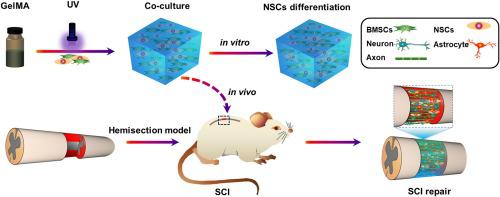Colloids and Surfaces B: Biointerfaces ( IF 5.4 ) Pub Date : 2020-06-24 , DOI: 10.1016/j.colsurfb.2020.111214 Pinghui Zhou 1 , Panpan Xu 2 , Jingjing Guan 2 , Changchun Zhang 2 , Jianrong Chang 3 , Fugen Yang 4 , Hui Xiao 2 , Hengheng Sun 4 , Zhuoran Zhang 2 , Mengqing Wang 4 , Jianguo Hu 5 , Yingji Mao 6

|
Spinal cord injury (SCI) affects millions of people worldwide, and results in the loss of neurons and limited recovery of functions. Bone mesenchymal stem cells (BMSCs) and neural stem cells (NSCs) can proliferate or differentiate into other specific cell types. These cells represent potential treatments for SCIs. However, recent studies have shown that NSCs mainly differentiate into astrocytes, rather than neurons, in the microenvironment of an SCI. BMSCs have been reported to promote neuronal differentiation of NSCs and reduce the formation of astrocytes. Furthermore, three-dimensional (3D) gelatin methacryloyl (GelMA) provides superior mechanical properties and functional characteristics for cell proliferation, migration, and differentiation. In this study, we proposed a functional scaffold developed by loading BMSCs and NSCs into 3D GelMA hydrogel. BMSCs and NSCs that were photo-encapsulated in the 3D GelMA hydrogel survived and demonstrated good proliferation in vitro. The NSCs differentiated more toward neurons and oligodendrocytes than toward astrocytes, a phenomenon more noticeable in low-modulus hydrogels. When functional hydrogel scaffolds, loaded with BMSCs and NSCs, were implanted into the hemisection site of the rat spinal cord, they could significantly promote motor function recovery and neuronal differentiation, and decrease glial scarring, fibrotic scarring, and inflammatory responses. The immense therapeutic potential of this system to promote axonal regeneration was thereby demonstrated. Taken together, loading of the GelMA scaffold with BMSCs and NSCs is a promising therapeutic strategy to trigger functional regeneration of the spinal cord.
中文翻译:

在水凝胶中促进脊髓再生的3D神经元分化。
脊髓损伤(SCI)影响全球数百万人,并导致神经元丧失和功能恢复受限。骨髓间充质干细胞(BMSC)和神经干细胞(NSC)可以增殖或分化为其他特定细胞类型。这些细胞代表了SCI的潜在治疗方法。但是,最近的研究表明,在SCI的微环境中,NSC主要分化为星形胶质细胞,而不是神经元。据报道,BMSC促进NSC的神经元分化并减少星形胶质细胞的形成。此外,三维(3D)明胶甲基丙烯酰基(GelMA)为细胞增殖,迁移和分化提供了卓越的机械性能和功能特性。在这个研究中,我们提出了通过将BMSC和NSC加载到3D GelMA水凝胶中而开发的功能支架。光包裹在3D GelMA水凝胶中的BMSC和NSC存活并显示出良好的增殖体外。NSCs向神经元和少突胶质细胞的分化比向星形胶质细胞的分化更大,这种现象在低模量水凝胶中更为明显。当将装有BMSC和NSC的功能性水凝胶支架植入大鼠脊髓的半切部位时,它们可以显着促进运动功能的恢复和神经元分化,并减少神经胶质瘢痕形成,纤维化瘢痕形成和炎症反应。从而证明了该系统促进轴突再生的巨大治疗潜力。综上所述,用BMSC和NSC装载GelMA支架是触发脊髓功能再生的有前途的治疗策略。











































 京公网安备 11010802027423号
京公网安备 11010802027423号